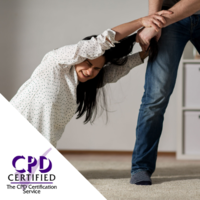Description
All about this Domestic Violence course Throughout this course, you will learn that being a victim of domestic abuse can cause complex and distressing behaviours. You will also consider the power and control wheel, which reflects the common themes and experiences of victims who have been subjected to one or more abusive relationships. You will learn the factors that make someone more susceptible to domestic violence and that whilst there are risk factors for many individuals, anyone can become a victim of domestic violence. There can be some barriers in trying to support someone who is experiencing domestic abuse, so knowing how individuals can be supported is important, this will also be covered in one of the units. You will learn about safety planning, and that it is a form of plan that the victim can put into place if they are subject to violence and decide that they are going to leave the situation. In this course you will consider that controlling and coercive behaviours are at the foundation of all kinds of domestic violence, where the abuser seeks to gain control of the victim through various kinds of violence and abuse. As with any kind of abuse, the physical damage that it can cause will vary greatly depending on the circumstances. You will learn the typical physical damages and the emotional distress this can cause the victim. At the end of this course you will look at the different local sources of help that individuals can seek out. In order to complete the course, you must achieve 80 or more in the final multiple choice quiz. You will earn 3 CPD points on completion of the course, this course will take around 3 hours to complete and the certificate will last for two years. Fully CPD registered Completed online with instant downloadable certificate Fully printed certificate posted next day Covers domestic violence legislation, including Clare’s Law Complete the online multiple choice assessment as many times as you need to pass Units covered Unit 1 – Introduction to domestic violence – This unit introduces the concept of domestic violence, examining what the term means and what some of the myths are that are widely accepted about domestic violence, despite not being an accurate reflection of what it is – these myths will be dispelled. The unit continues with an examination of the kinds of domestic abuse that an individual can experience and who is most susceptible to domestic violence and why. Unit 2 – The key elements of domestic violence – This unit considers what some of the key elements of domestic violence are in relation to the behaviours that are experienced by both the abuser and the victim. It considers the nature of controlling and coercive behaviours and what gaslighting is in relation to domestic violence. There is also consideration of the kinds of threats and intimidation that abusers can use to control their victims and how financial abuse works to ensure that a victim becomes reliant on their abuser. Unit 3 – Impact on the victim and their families – This unit considers the foundation of coercive and controlling behaviour whilst examining how this then leads to a cycle of domestic abuse. There is consideration of who is most likely to be a victim of domestic abuse and what the impacts of domestic abuse can be for victims and for children as well. The unit ends with a case study to highlight the impact that domestic violence can have on a family. Unit 4 – Responding to concerns – This unit explores how to respond to concerns about domestic violence, looking at how best to support someone who is experiencing domestic violence and what to avoid when doing so. The unit considers what to do in an emergency and how victims may use positive and negative coping strategies to try and manage the situation in which they find themselves. The unit ends with consideration of what a safety plan is and what it should contain, should the victim find themselves in a crisis situation. Unit 5 – Reporting domestic violence – This unit considers the reporting of domestic violence and examines the choices of victims in terms of the legalities of being a victim of domestic violence. There is consideration of the role of the Police, Social Services and the effects of multi-agency working and multi-agency conferences to support victims who are at serious risk of harm. The unit ends with local and national information about sources of support for people who are or who have been victims of domestic abuse.

Reviews
There are no reviews yet.